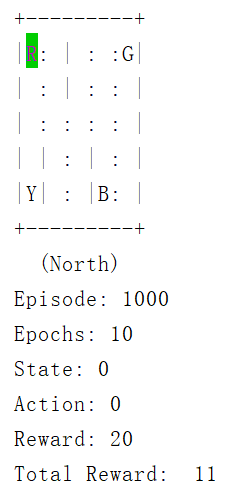Hands-On Reinforcement Learning With Python——Temporal Difference Learning
作者:凯鲁嘎吉 - 博客园 http://www.cnblogs.com/kailugaji/
更多请看:Reinforcement Learning - 随笔分类 - 凯鲁嘎吉 - 博客园 https://www.cnblogs.com/kailugaji/category/2038931.html
$\epsilon $-贪心策略:

1. SARSA
1.1 算法流程

1.2 Python程序
# -*- coding: UTF-8 -*-
# Solving the Taxi Problem using SARSA
# From: https://github.com/AndyYue1893/Hands-On-Reinforcement-Learning-With-Python
# https://www.cnblogs.com/kailugaji/ - 凯鲁嘎吉 - 博客园
'''
出租车调度
这里有 4 个地点,分别用 4 个字母表示,任务是要从一个地点接上乘客,送到另外 3 个中的一个放下乘客,越快越好。
颜色:蓝色:乘客,红色:乘客的目的地,黄色:空出租车,绿色:出租车满座,其中 “:” 栅栏可以穿越,"|" 栅栏不能穿越
Reward: 成功运送一个客人获得 20 分奖励
每走一步损失 1 分(希望尽快送到目的地)
没有把客人放到指定的位置,损失 10 分
Action: 0:向南移动,1:向北移动,2:向东移动,3:向西移动,4:乘客上车,5:乘客下车
State: 500维,(出租车行、出租车列、乘客位置、目的地)
'''
import random
import gym
from time import sleep
env = gym.make('Taxi-v3') #创建出租车游戏环境
env.render() # 用于渲染出当前的智能体以及环境的状态
# 将Q表初始化为一个字典,它存储指定在状态s中执行动作a的值的状态-动作对。
Q = {}
for s in range(env.observation_space.n):
for a in range(env.action_space.n):
Q[(s,a)] = 0.0
# epsilon贪心策略函数
def epsilon_greedy(state, epsilon):
if random.uniform(0,1) < epsilon:
return env.action_space.sample() # 随机,用epsilon概率探索新动作
else:
return max(list(range(env.action_space.n)), key = lambda x: Q[(state,x)]) # 用1-epsilon的概率选择Q表最佳动作
# 初始化变量
alpha = 0.4 # TD学习率
gamma = 0.999 # 折扣率
epsilon = 0.017 # 贪心策略中epsilon的值
num_episodes = 1000 # 玩几局游戏
# 执行SARSA
for episode in range(num_episodes): # 玩几局游戏
steps, r = 0, 0 # 每局走多少步,总体奖励
state = env.reset() # 用于重置环境
# select the action using epsilon-greedy policy
action = epsilon_greedy(state, epsilon)
while True:
steps += 1 # 每局走多少步
env.render() # 用于渲染出当前的智能体以及环境的状态
# then we perform the action and move to the next state, and receive the reward
nextstate, reward, done, _ = env.step(action)
# again, we select the next action using epsilon greedy policy
nextaction = epsilon_greedy(nextstate, epsilon)
# we calculate the Q value of previous state using our update rule
Q[(state, action)] += alpha * (reward + gamma * Q[(nextstate, nextaction)] - Q[(state, action)])
# Q(s, a) <- Q(s, a) + alpha (r + gamma Q(s', a') - Q(s, a))
# finally we update our state and action with next action and next state
action = nextaction # a <- a'
state = nextstate # s <- s'
# store the rewards
r += reward # reward: 即时奖励, r: total reward
# we will break the loop, if we are at the terminal state of the episode
if done:
break
print(f"Episode: {episode + 1}") # 玩几局游戏
print(f"Epochs: {steps}") # 每局走多少步
print(f"State: {state}")
print(f"Action: {action}")
print(f"Reward: {reward}")
print("Total Reward: ", r)
# sleep(0.01) # 为了让显示变慢,否则画面会非常快
env.close()
1.3 结果

2. Q-Learning
2.1 算法流程

2.2 Python程序
# -*- coding: UTF-8 -*-
# Solving the Taxi Problem using Q Learning
# From: https://github.com/AndyYue1893/Hands-On-Reinforcement-Learning-With-Python
# https://www.cnblogs.com/kailugaji/ - 凯鲁嘎吉 - 博客园
'''
出租车调度
这里有 4 个地点,分别用 4 个字母表示,任务是要从一个地点接上乘客,送到另外 3 个中的一个放下乘客,越快越好。
颜色:蓝色:乘客,红色:乘客的目的地,黄色:空出租车,绿色:出租车满座,其中 “:” 栅栏可以穿越,"|" 栅栏不能穿越
Reward: 成功运送一个客人获得 20 分奖励
每走一步损失 1 分(希望尽快送到目的地)
没有把客人放到指定的位置,损失 10 分
Action: 0:向南移动,1:向北移动,2:向东移动,3:向西移动,4:乘客上车,5:乘客下车
State: 500维,(出租车行、出租车列、乘客位置、目的地)
'''
import random
import gym
from time import sleep
env = gym.make('Taxi-v3') #创建出租车游戏环境
env.render() # 用于渲染出当前的智能体以及环境的状态
# 将Q表初始化为一个字典,它存储指定在状态s中执行动作a的值的状态-动作对。
q = {}
for s in range(env.observation_space.n):
for a in range(env.action_space.n):
q[(s,a)] = 0.0
# 定义一个名为update_q_table的函数,根据q学习更新规则更新q值
def update_q_table(prev_state, action, reward, nextstate, alpha, gamma):
qa = max([q[(nextstate, a)] for a in range(env.action_space.n)]) # 取一个状态-动作对的最大值,并将其存储在一个名为qa的变量中
# max Q(s', a')
q[(prev_state, action)] += alpha * (reward + gamma * qa - q[(prev_state, action)]) # 用更新规则更新前一个状态的Q值
# Q(s, a) <- Q(s, a) + alpha (r + gamma max Q(s', a') - Q(s, a))
# epsilon贪心策略函数
def epsilon_greedy_policy(state, epsilon):
if random.uniform(0,1) < epsilon:
return env.action_space.sample() # 随机,用epsilon概率探索新动作
else:
return max(list(range(env.action_space.n)), key = lambda x: q[(state,x)]) # 用1-epsilon的概率选择Q表最佳动作
# 初始化变量
alpha = 0.4 # TD学习率
gamma = 0.999 # 折扣率
epsilon = 0.017 # 贪心策略中epsilon的值
num_episodes = 1000 # 玩几局游戏
# 执行Q-Learning
for episode in range(num_episodes): # 玩几局游戏
steps, r = 0, 0 # 每局走多少步,总体奖励
prev_state = env.reset() # 用于重置环境
while True:
steps += 1 # 每局走多少步
env.render() # 用于渲染出当前的智能体以及环境的状态
# In each state, we select the action by epsilon-greedy policy
action = epsilon_greedy_policy(prev_state, epsilon)
# then we perform the action and move to the next state, and receive the reward
nextstate, reward, done, _ = env.step(action)
# Next we update the Q value using our update_q_table function
# which updates the Q value by Q learning update rule
update_q_table(prev_state, action, reward, nextstate, alpha, gamma)
# Finally we update the previous state as next state
prev_state = nextstate # s <- s'
# Store all the rewards obtained
r += reward # reward: 即时奖励, r: total reward
# we will break the loop, if we are at the terminal state of the episode
if done:
break
print(f"Episode: {episode + 1}") # 玩几局游戏
print(f"Epochs: {steps}") # 每局走多少步
print(f"State: {prev_state}")
print(f"Action: {action}")
print(f"Reward: {reward}")
print("Total Reward: ", r)
# sleep(0.01) # 为了让显示变慢,否则画面会非常快
env.close()
2.3 结果

3. 参考文献
[1] https://github.com/sudharsan13296/Hands-On-Reinforcement-Learning-With-Python
[2] 邱锡鹏,神经网络与深度学习,机械工业出版社,https://nndl.github.io/, 2020.